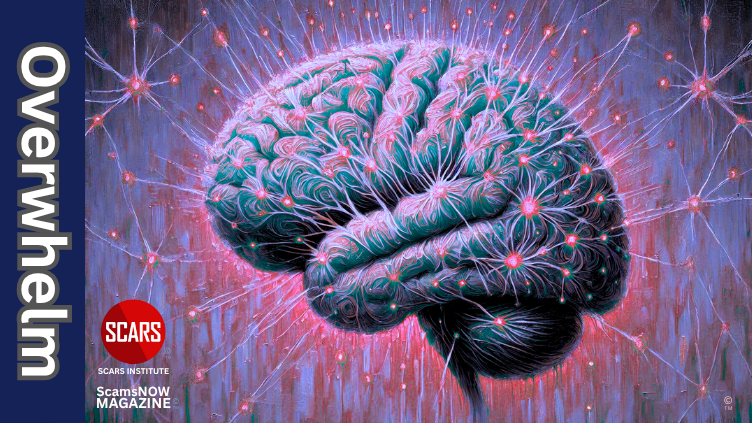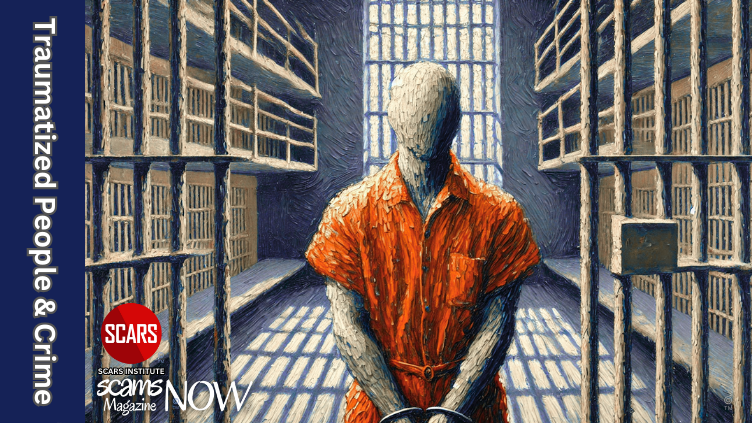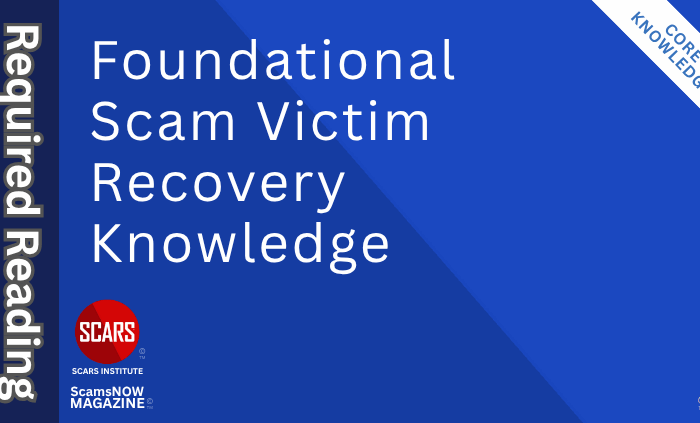
Criminal Advantage – Always One Step Ahead
Why Criminals Always Seem One Step Ahead of Society and Law Enforcement
Primary Category: Criminology
Author:
• Tim McGuinness, Ph.D., DFin, MCPO, MAnth – Anthropologist, Scientist, Polymath, Director of the Society of Citizens Against Relationship Scams Inc.
• Debby Montgomery Johnson, President and CEO of BenfoComplete.com, Online Scam/Fraud Survivors Advocate, Author, Keynote Speaker, Trainer, Podcast Host, USAF Veteran, Chair and Director of the Society of Citizens Against Relationship Scams Inc.
Author Biographies Below
About This Article
The “Criminal Advantage” stems from and refers to a mindset untethered from conventional morality, enabling relentless pursuit of self-interest, rapid exploitation of loopholes, and adaptation faster than social defenses. Criminals cultivate a predator’s perspective, reading routines, spotting weak points, and using deception, patience, and organization to strike with precision. Motivations span financial gain, power, status, revenge, addiction, and entitlement, while successful enterprises mirror efficient firms with roles, hierarchy, and agile strategy. The text traces criminality’s documentation from ancient legal codes to modern patterns, and draws instructive parallels with predatory and deceptive behaviors in the animal kingdom. This advantage is amplified by invisibility in plain sight, social engineering, and the contagious spread of criminal thinking within environments that normalize exploitation. The societal toll includes eroded trust, economic harm, and pressure for intrusive controls. Mitigating the imbalance requires institutions that anticipate opportunism, citizens and systems that adapt quickly, and policies grounded in a realistic understanding of criminal drivers and methods.
Note: This article is intended for informational purposes and does not replace professional medical advice. If you are experiencing distress, please consult a qualified mental health professional.

The Criminal Advantage: Why Criminals Always Seem One Step Ahead of Society and Law Enforcement
Author’s Note
In the complexity of our society, there always seems to be a ‘criminal advantage’. There is a pervasive notion that criminals always seem to have the upper hand. This advantage is not merely a product of luck or chance but is deeply rooted in the criminal mindset, which operates on a different moral and ethical framework than that of law-abiding citizens. To understand why criminals often hold this advantage, it is essential to delve into the drivers, morality, and organizational skills that define the criminal world.
The purpose of this article is to help victims better understand what is so difficult for them to understand: Why someone would exploit them. We hope this helps.
Prof. Tim McGuinness, Ph.D.
Debby Montgomery Johnson
Definition of Criminality and Criminal Behavior in Society
Criminality, in the context of society, refers to actions or behaviors that violate established laws, norms, and moral codes, resulting in harm, loss, or disruption to individuals, communities, or the broader social fabric. Criminal behavior encompasses a wide range of activities, from minor infractions to serious offenses, and is characterized by a deliberate intent to commit acts that are prohibited by legal and social standards.
At its core, criminality involves the breach of social contracts and the intentional disregard for the rights and well-being of others. This can manifest in various forms, including theft, assault, fraud, and murder, among others. What defines these actions as criminal is not only their illegality but also their impact on society, which can include physical harm, financial loss, emotional distress, and the erosion of social trust.
Criminal behavior is often motivated by a variety of factors, including personal gain, power, revenge, or a sense of entitlement. Criminals may operate individually or as part of organized groups, utilizing strategies and tactics to evade detection and punishment. The sophistication of criminal activities can range from simple opportunistic theft to complex, coordinated operations involving multiple participants and resources.
Society responds to criminality through legal systems, law enforcement, and judicial processes, which aim to deter, prevent, and punish criminal behavior. These systems are designed to maintain social order, protect the rights of citizens, and ensure justice for victims. However, the effectiveness of these responses can be challenged by the adaptability and ingenuity of criminals, who continually seek new methods to exploit vulnerabilities in the system.
Understanding criminality requires a multifaceted approach that considers psychological, sociological, and environmental factors. It involves recognizing the complex interplay between individual motivations, social influences, and the structural conditions that can either facilitate or inhibit criminal behavior. By examining these dynamics, society can develop more effective strategies to address the root causes of criminality and create a safer, more just environment for all.
The Criminal Advantage Mindset: A Different Moral Compass
Criminals operate with a distinct moral and ethical code that often stands in stark contrast to societal norms, and this is their criminal advantage. For them, the traditional boundaries of right and wrong are fluid and adaptable, allowing them to exploit opportunities that honest individuals might overlook or dismiss. This lack of common societal morality provides criminals with a unique perspective, enabling them to see potential for gain where others see only constraints.
The criminal mindset is characterized by a relentless pursuit of self-interest, almost always at the expense of others. This single-minded focus allows criminals to identify and capitalize on vulnerabilities in society, whether through fraud, theft, or other illicit activities. Their ability to disregard social and legal norms gives them a flexibility that honest people lack, making them more adaptable and responsive to changing circumstances.
Opportunity Seeking: The Criminal’s Constant Pursuit
One of the defining features of the criminal mindset is an insatiable appetite for opportunity. Criminals are constantly on the lookout for ways to exploit systems, individuals, and situations to their advantage. This opportunistic nature is a significant factor in their ability to stay ahead of law enforcement and honest citizens.
Criminals are adept at identifying gaps and weaknesses in security measures, legal frameworks, and social structures. They understand that in a world of rules and regulations, there will always be loopholes and blind spots that can be exploited. This keen eye for opportunity allows them to act quickly and decisively, often before their targets or authorities can react.
Organization and Strategy: The Hallmark of Successful Criminals
While not all criminals are highly organized, those who rise to the top of their illicit professions often exhibit remarkable organizational skills. Successful criminals understand the importance of planning, coordination, and execution. They are strategic thinkers who can anticipate and counter potential obstacles, whether from law enforcement or rival criminal enterprises.
Organized crime groups, in particular, demonstrate a high level of sophistication in their operations. They often have clearly defined roles and hierarchies, allowing for efficient decision-making and resource allocation. This organizational prowess enables them to conduct complex operations, such as drug trafficking or money laundering, with a level of efficiency that rivals legitimate businesses.
Criminal Vision: The Predator’s Perspective
The criminal mindset can be likened to that of a predator in the wild, constantly scanning the environment for opportunities and vulnerabilities. This “criminal vision” is a unique way of perceiving the world, one that is honed to identify potential targets and exploit them with precision and efficiency. Understanding this predatory perspective is crucial to grasping why criminals often seem to be several steps ahead of their prey.
The Predator’s Gaze: A World of Opportunities
For a predator, the world is a vast landscape of opportunities and threats. Similarly, criminals view society through a lens that highlights potential gains and the weaknesses of their targets. This vision is not merely about seeing what is present but about anticipating what could be. Criminals are adept at recognizing patterns, identifying routines, and spotting gaps in security measures. They understand that in a world of order, there will always be chaos and disorder that can be exploited.
This predatory gaze is not limited to humans; it is a trait shared by many species in the animal kingdom. For example, a lion stalking its prey in the savannah uses its keen senses and instincts to identify the weakest or most isolated member of a herd. Similarly, a criminal might target an elderly person walking alone at night, recognizing them as a vulnerable and easy mark. This ability to identify and exploit weaknesses is a hallmark of the predator’s mindset, whether in the wild or in the criminal underworld.
The Art of Deception: Masking Intentions
Predators in the animal world often use camouflage and stealth to get close to their prey without being detected. Criminals employ a similar strategy, using deception and social engineering to mask their true intentions. They might present themselves as trustworthy individuals, gaining the confidence of their targets before striking. This ability to blend in and deceive is a critical component of the criminal vision, allowing them to operate undetected for extended periods.
In the natural world, a chameleon changes its color to match its surroundings, becoming almost invisible to potential threats and prey. Similarly, a criminal might adopt a false identity or create a convincing cover story to avoid suspicion and gain access to their targets. This deceptive approach is a powerful tool, enabling criminals to manipulate their environment and the people within it to their advantage.
The Hunt: Strategic and Patient
The hunt is a strategic and often patient endeavor for predators. They may spend hours, days, or even weeks observing their prey, learning their habits and behaviors before making their move. Criminals adopt a similar approach, conducting extensive reconnaissance and planning their actions with meticulous care. This patience and strategic thinking are essential to their success, allowing them to strike at the most opportune moment.
In the animal kingdom, a cheetah might stalk its prey for miles, waiting for the perfect opportunity to launch a high-speed chase. Similarly, a criminal might spend months gathering information on a potential target, waiting for the right moment to execute their plan. This level of patience and strategic foresight is a key aspect of the criminal vision, enabling them to act with precision and effectiveness.
The Kill: Exploiting Vulnerabilities
For predators, the kill is the culmination of their hunt, a moment of exploitation where they take advantage of their prey’s vulnerabilities. Criminals view their actions in a similar light, seeing the exploitation of their targets as a necessary and often inevitable outcome. This mindset allows them to act without hesitation, seizing opportunities as they arise.
In nature, a crocodile might lie in wait for days, its body submerged beneath the water’s surface, waiting for an unsuspecting animal to come within striking distance. Similarly, a criminal might lie in wait, biding their time until the perfect moment to strike. This ability to exploit vulnerabilities with speed and precision is a defining characteristic of the predator’s mindset, whether in the wild or in the criminal world.
The Aftermath: Learning and Adapting
Predators in the wild are constantly learning and adapting, using each hunt as an opportunity to refine their skills and strategies. Criminals adopt a similar approach, analyzing their successes and failures to improve their tactics and avoid detection in the future. This adaptive nature is a crucial aspect of the criminal vision, allowing them to stay one step ahead of their pursuers.
In the animal kingdom, a wolf pack might change its hunting strategies based on the behavior of its prey, adapting to new challenges and opportunities. Similarly, a criminal might alter their methods in response to changes in law enforcement tactics or societal norms, ensuring their continued success and survival. This ability to learn and adapt is a powerful tool, enabling criminals to evolve and thrive in an ever-changing environment.
Remember
The criminal vision is a predatory perspective that sees the world as a landscape of opportunities and vulnerabilities. It is a mindset that is honed to identify and exploit weaknesses, using deception, patience, and strategic thinking to achieve its goals. This vision is not unique to humans; it is a trait shared by many species in the animal kingdom, where predators use their instincts and skills to survive and thrive.
Understanding this predatory perspective is crucial for comprehending the criminal advantage. By recognizing the patterns and behaviors that define the criminal vision, society can better anticipate and counter the threats posed by those who operate outside the bounds of conventional morality and ethics. Only then can the balance of power be shifted, ensuring that the advantages once held by criminals are neutralized and the safety and security of all citizens are upheld.
The Invisible Criminal: Why They Are Hard to See and Catch
The criminal advantage is further enhanced by their ability to blend into society and avoid detection. Many criminals are adept at maintaining a facade of normality, making it difficult for authorities and the public to identify them as threats. This ability to remain invisible is a critical factor in their success and longevity in criminal activities.
Criminals often exploit the trust and goodwill of their victims, using social engineering and deception to gain access to sensitive information or resources. They understand that people are more likely to lower their guard around someone they perceive as trustworthy, making it easier for them to strike when least expected.
The Criminal Mind as a Mind Virus
The criminal mindset can also be seen as a kind of mind virus, constantly expanding and infecting more people. This metaphor is apt because, like a virus, the criminal way of thinking can spread rapidly and have far-reaching effects. Individuals who come into contact with criminal activities, whether as victims or accomplices, can find themselves drawn into the criminal world, adopting its values and practices.
This contagion effect is particularly pronounced in environments where criminal activities are normalized or even glorified. In such settings, the line between legitimate and illegitimate activities can blur, making it easier for individuals to justify and engage in criminal behavior. The spread of criminal thinking can also be facilitated by media portrayals that romanticize or sensationalize crime, influencing public perception and attitudes.
Also, like a virus, individuals can cure themselves of it, though we believe they retain the criminal vision or perspective. This is one of the reasons why reformed criminals are so valuable in cybersecurity and the physical security world.
Basic Criminal Drivers: What Motivates the Criminal Mind
Understanding the drivers behind criminal behavior is crucial to comprehending the criminal advantage. While motivations can vary widely, some common drivers include financial gain, power and control, status and prestige, revenge and retribution, and addiction and desperation. Financial gain is a primary motivator for many criminals, as the promise of significant wealth can override moral and legal considerations, driving individuals to engage in fraud, theft, and other economic crimes.
The allure of power and control can also be a powerful driver, leading criminals to seek influence through extortion, human trafficking, or political corruption. Status and prestige within criminal subcultures can motivate individuals to engage in acts of violence, theft, or other illicit activities to achieve recognition and respect. Personal grievances and a desire for revenge can push individuals into criminal behavior as a means of exacting retribution.
Additionally, substance abuse and financial desperation can lead people to criminal activities to support their habits or meet basic needs, often resulting in a cycle of increasingly desperate and dangerous behavior. Another significant driver is entitlement, where criminals believe they are inherently deserving of advantages and are justified in taking them, even at the expense of others. This sense of entitlement can manifest in various forms of exploitation and manipulation, as these individuals see themselves as above the rules and societal norms that constrain others.
While motivations can vary widely, some common drivers include:
- Entitlement: Rarely does society talk about its failures, but one of them is to raise children who fundamentally believe they are special. This is the foundation of entitlement, and with it comes a belief that hay can, in fact, have a right to take advantage of society.
- Financial Gain: The pursuit of wealth and material possessions is a primary motivator for many criminals. The promise of significant financial rewards can override moral and legal considerations, driving individuals to engage in fraud, theft, and other economic crimes.
- Power and Control: For some, the allure of power and the ability to control others is a powerful motivator. Criminals who seek power may engage in activities such as extortion, human trafficking, or even political corruption to consolidate their influence.
- Status and Prestige: In certain criminal subcultures, status and prestige are highly valued. Individuals may turn to crime as a means of achieving recognition and respect within their peer group, whether through acts of violence, theft, or other illicit activities.
- Revenge and Retribution: Personal grievances and a desire for revenge can also drive criminal behavior. Individuals who feel wronged may seek to exact retribution through illegal means, targeting those they perceive as responsible for their misfortune.
- Addiction and Desperation: Substance abuse and financial desperation can push individuals into criminal activities as a means of supporting their habits or meeting basic needs. The cycle of addiction can be particularly difficult to break, leading to a spiral of increasingly desperate and dangerous criminal behavior.
Criminal Morality and Ethics: A Different Ethical Framework
The criminal world operates on a unique ethical framework that often stands in stark contrast to societal norms. In this framework, loyalty to one’s criminal associates and the pursuit of self-interest are paramount. Criminals may adhere to a code of honor within their own groups, but this code is often ruthless and uncompromising, with little regard for the well-being of outsiders.
This different ethical framework allows criminals to justify their actions in ways that would be unthinkable to law-abiding citizens. For example, a criminal might view the exploitation of vulnerable individuals as a necessary evil in the pursuit of their goals or see violence as a legitimate means of resolving conflicts. This flexibility in moral reasoning gives them a strategic advantage, allowing them to adapt their behavior to suit their needs without the constraints of conventional ethics.
The Criminal Organization: A Model of Efficiency
Successful criminal organizations are often models of efficiency, with clearly defined roles, hierarchies, and protocols. These organizations understand the importance of specialization, with members taking on specific tasks such as recruitment, intelligence gathering, or logistics. This division of labor allows for a high degree of expertise and efficiency in their operations.
Criminal organizations also excel at adapting to changing circumstances and threats. They are often quick to exploit new technologies and methods, staying ahead of law enforcement through innovation and adaptability. Their ability to evolve and respond to challenges makes them formidable opponents, capable of sustaining their activities over long periods.
The First Appearance of Documented Criminality in Human Civilization
The first documented instances of criminality in human civilization are deeply intertwined with the emergence of early societies and the development of legal systems. As human communities transitioned from nomadic hunter-gatherer lifestyles to more sedentary and organized societies, the need for rules and punishments became evident. This period, often referred to as the Neolithic Revolution, marked a significant shift in human behavior and social structures, laying the groundwork for the first recorded instances of criminal activity.
One of the earliest known examples of documented criminality can be traced back to ancient Mesopotamia, often considered the cradle of civilization. The Code of Ur-Nammu, created around 2100-2050 BCE, is one of the oldest known legal codes and provides insights into the types of crimes and punishments that existed during that time. This code addressed issues such as theft, assault, and murder, indicating that these were prevalent concerns in early urban societies. The Code of Hammurabi, which followed a few centuries later, further elaborated on legal principles and punishments, reflecting the complexity of social interactions and the need for a structured legal system.
In ancient Egypt, the Judicial Papyrus of Turin, dating back to around 1150 BCE, contains one of the earliest known legal documents. It outlines various crimes and their corresponding punishments, including theft, damage to property, and assault. The papyrus provides a glimpse into the legal mindset of ancient Egyptians and their efforts to maintain order within their society.
The ancient Greeks also contributed to the documentation of criminality with their legal texts and philosophical discussions. The works of Plato and Aristotle, for instance, delve into the nature of justice and the role of law in society. The Athenian legal system, with its focus on public trials and democratic principles, set a precedent for how legal systems could address criminal behavior and ensure justice.
In the Eastern world, the legal traditions of ancient China, particularly during the Zhou Dynasty (1046-256 BCE), also documented various forms of criminality. The “Rites of Zhou“ and other legal texts from this period outline crimes such as treason, corruption, and theft, reflecting the complex social and political structures of the time.
These early legal codes and documents not only provide a window into the types of crimes that were committed but also reveal the societal values and norms of their respective civilizations. They show that as human societies became more complex, so did the need for legal frameworks to address criminal behavior and maintain social order.
The first appearance of documented criminality in human civilization thus marks a pivotal moment in the development of law and society. It reflects the human need to establish rules, define acceptable behavior, and create mechanisms for justice and punishment. These early documents serve as the foundation for understanding the evolution of criminality and the legal systems that have sought to address it throughout history.
Criminality in the Animal Kingdom: Nature’s Predators and Deceivers
While the concept of criminality is typically reserved for human behavior, there are fascinating parallels in the animal kingdom where certain species exhibit predatory and deceptive behaviors that can be seen as analogous to criminal activities. These behaviors, driven by survival instincts and the need to exploit resources, offer insights into the evolutionary roots of what we consider criminal in human society.
Predatory Behavior: The Hunt for Survival
Predatory behavior is perhaps the most obvious parallel to criminality in the animal kingdom. Predators such as lions, wolves, and sharks use their strength, speed, and stealth to hunt and kill their prey. These animals are masters of deception, often using camouflage and ambush tactics to catch their targets off guard. For example, a lioness might stalk a herd of gazelles for hours, waiting for the right moment to separate a vulnerable individual from the group before launching a swift and lethal attack. This strategic and patient approach to hunting mirrors the calculated and opportunistic behavior of human criminals.
Deception and Manipulation: The Art of the Con
Deception is another tactic employed by animals that can be likened to criminal behavior. Many species use deception to gain an advantage, whether it’s to acquire food, mates, or territory. For instance, the mimic octopus can change its color and texture to mimic other marine animals, such as sea snakes or lionfish, to deter potential predators or prey. Similarly, some birds, like the Australian bowerbird, create elaborate structures to attract mates, using stolen or borrowed objects to enhance their appeal. These deceptive strategies, while serving evolutionary purposes, can be seen as a form of manipulation that parallels human deception and fraud.
Cooperation and Organization: The Power of the Pack
Some animal species exhibit remarkable levels of cooperation and organization, which can be compared to the structured criminal enterprises seen in human societies. Wolves, for example, operate in tightly knit packs with clearly defined roles and hierarchies. Each member of the pack contributes to the hunt, with some acting as scouts, others as hunters, and still others as protectors of the young. This division of labor and strategic coordination allows wolf packs to take down much larger prey, such as bison or moose, demonstrating a level of organization and teamwork that is reminiscent of human criminal syndicates.
Opportunity Seeking: The Scavenger’s Advantage
Opportunity seeking is a behavior shared by many animal species, particularly scavengers. Vultures, hyenas, and jackals are known to follow predators, waiting for the chance to scavenge the remains of their kills. These animals are adept at recognizing and exploiting opportunities, much like human criminals who seek out vulnerable targets or situations. For example, a hyena might follow a pride of lions, waiting for the lions to make a kill before moving in to steal the spoils. This opportunistic behavior is driven by the need to maximize resources with minimal effort, a strategy that can be seen as analogous to criminal opportunism.
Entitlement: The Dominant Animal’s Claim
The concept of entitlement, where certain animals believe they are entitled to resources or dominance, can also be observed in the animal kingdom. Alpha males in many species, such as chimpanzees and elephants, assert their dominance and claim resources, often through displays of strength and aggression. These dominant animals may bully or displace subordinates to secure access to food, mates, or territory. This sense of entitlement and the willingness to use force to maintain it can be seen as a parallel to human criminal behavior driven by a similar mindset.
Remember
While the animal kingdom does not have laws or legal systems, many species exhibit behaviors that can be seen as analogous to criminal activities in human society. Predatory behavior, deception, cooperation, opportunity seeking, and entitlement are all strategies employed by animals to gain an advantage and ensure their survival. Understanding these behaviors provides a unique perspective on the evolutionary roots of criminality and highlights the complex and often ruthless nature of the animal world. By recognizing these parallels, we can gain a deeper appreciation for the diverse strategies that have evolved to ensure the success and survival of different species, including our own.
The Impact on Society: A Constant Threat
The criminal advantage has significant implications for society as a whole. Criminal activities can undermine the fabric of social trust, erode economic stability, and create an atmosphere of fear and insecurity. The constant threat of crime can lead to increased surveillance, restrictions on personal freedoms, and a general sense of unease among the population.
Moreover, the criminal mindset’s contagious nature means that its influence can spread beyond the confines of the criminal underworld, affecting the attitudes and behaviors of law-abiding citizens. This can lead to a cycle of mistrust and cynicism, where individuals become more willing to engage in questionable or illegal activities themselves.
Conclusion
The criminal advantage is a complex phenomenon rooted in the unique mindset, morality, and organizational skills of criminals. Their lack of common moral constraints, coupled with a relentless pursuit of opportunity and a high degree of organization, allows them to stay one step ahead of law enforcement and honest citizens. Understanding these dynamics is crucial for developing effective strategies to combat crime and protect society from its deleterious effects.
As the criminal mindset continues to spread and evolve, it is essential for individuals and institutions to remain vigilant and adaptable. By recognizing the patterns and drivers of criminal behavior, society can better anticipate and counter the threats posed by those who operate outside the bounds of conventional morality and ethics. Only then can the balance of power be shifted, ensuring that the advantages once held by criminals are neutralized and the safety and security of all citizens are upheld.

Glossary
- Adaptive opportunism — This concept describes a criminal’s habit of switching tactics as conditions change. It reflects a flexible mindset that treats every new rule or obstacle as a fresh path to gain. Victims benefit when responders anticipate pivots rather than a single fixed method.
- Ambush planning — This process involves quiet observation followed by a sudden move on a chosen weakness. It relies on patience, timing, and a clear exit plan. Lawful actors often miss it because daily routines feel safe until the moment of attack.
- Anchor routine — This term refers to a predictable habit that offenders use to track and time a target. Commuting patterns, posting schedules, and payment cycles become guides for exploitation. Breaking patterns reduces exposure to planned harm.
- Boundary testing — This behavior probes rules and responses to learn what will trigger action. Small violations map limits without drawing full attention. Offenders then escalate once they understand tolerance levels.
- Camouflage persona — This crafted identity blends into a setting to avoid suspicion. It borrows trusted roles, familiar language, and ordinary behavior. The mask holds long enough to reach a goal and withdraw.
- Confidence erosion — This outcome occurs when repeated deception weakens a victim’s belief in their own judgment. Confusion and shame delay reporting and aid continued harm. Recovery starts when facts and timelines restore personal certainty.
- Containment corridor — This defensive plan narrows exposure while a case unfolds. It limits contact points, restricts financial flow, and separates risky channels from essentials. It buys time to assess damage and coordinate help.
- Counter-surveillance drift — This adjustment happens when offenders notice increased attention and subtly change routes or tools. The shift is gradual to avoid alerting observers. It preserves the scheme while authorities recalibrate.
- Criminal advantage — This phrase captures the lead that offenders gain by ignoring social limits and moving faster than systems. It grows from flexible ethics, organized effort, and rapid learning. Closing the gap requires equally adaptive defenses.
- Criminal contagion effect — This spread occurs when criminal thinking becomes normalized in a group or space. Admiration for rule breakers lowers barriers to imitation. Social reinforcement then sustains behavior that once felt unacceptable.
- Criminal justification narrative — This internal story reframes harm as necessary, deserved, or harmless. It removes guilt and smooths coordination among accomplices. The narrative collapses when facts and accountability disrupt its logic.
- Criminal organization cycle — This cycle moves from recruitment to planning, execution, and reinvestment. Roles and hierarchy sharpen skills and speed. The structure survives setbacks by replacing parts without stopping operations.
- Criminal patience — This trait reflects long periods of watching, logging patterns, and waiting for an ideal moment. It values certainty over haste. The delay pays off when defenses relax and a clean opportunity appears.
- Deception ladder — This pattern stacks small lies into a convincing scaffold. Each layer supports the next until the target accepts false premises as normal. The ladder collapses when an early rung is verified and disproved.
- Disguise through normality — This tactic hides wrongdoing inside ordinary routines. Regular work, family roles, and community presence deflect suspicion. The familiarity shields planning and movement.
- Disruption threshold — This point is where targeted changes finally break an offender’s plan. It may be a locked process, a blocked pathway, or a witness with documentation. Effective thresholds force costly resets.
- Exploit window — This interval opens when protection is weak and closes when controls return. Holidays, system changes, and staff turnover widen the window. Offenders plan around these gaps.
- Facade maintenance — This effort keeps an offender’s public image calm and consistent. Groomed appearances, polite messages, and staged generosity hold the cover. The facade cracks under cross-checked records.
- False scarcity cue — This signal claims an urgent or limited chance to pressure fast decisions. It overrides careful thinking and speeds transfers or access. Calm verification removes the pressure.
- Feedback learning loop — This loop reviews outcomes after each attempt and improves the next move. Offenders treat failure as information, not a stop sign. The loop builds skill and confidence over time.
- Harm amplification — This effect multiplies damage when delay allows added charges, new victims, or wider data loss. It results from unreported incidents and unrevoked access. Early interruption shrinks the scale.
- Hierarchy of roles — This structure assigns tasks such as scouting, logistics, communications, and enforcement. Clear roles increase speed and reduce errors. Replacement plans keep the machine running.
- Impunity economy — This environment rewards crime because consequences are rare or delayed. Bribes, social protection, or weak oversight lower risk. Profit grows when law feels distant.
- Invisibility in plain sight — This condition allows offenders to move freely while appearing ordinary. Familiar settings lull observers into ignoring small anomalies. Routine becomes the camouflage.
- Loophole mapping — This process identifies rules that do not account for edge cases. Offenders catalog exceptions and mismatches between systems. The map guides low-resistance routes.
- Moral disengagement — This shift disconnects actions from empathy and shared norms. Language softens harm and treats people as obstacles. Once detached, boundaries no longer restrain behavior.
- Opportunity scanning — This practice continuously surveys environments for weak points. Public schedules, unattended assets, and predictable workflows attract attention. Scanning never stops, even after a success.
- Pattern exploitation — This tactic uses known routines to time requests, ambushes, or diversions. Predictability becomes a tool for precise strikes. Breaking cadence reduces exposure.
- Predatory gaze — This perspective views settings as fields of risk and reward. It ranks targets by access, payoff, and defense. Decisions follow calculation rather than empathy.
- Preparation phase — This stage gathers intelligence, builds tools, and rehearses steps. It lays the foundations that make execution look effortless. Most of the work occurs before the first move.
- Reconnaissance log — This record stores observations about people, places, and systems. Dates, times, and behaviors become a playbook. The log guides when and how to act.
- Red flag normalization — This process turns small warnings into background noise. Familiarity dulls alarm even as risk grows. Restoring sensitivity requires explicit review.
- Resource pooling — This method combines skills, contacts, and funds to scale activity. Shared assets lower costs and speed operations. The pool replaces losses quickly.
- Risk displacement — This shift moves danger away from offenders and onto victims or intermediaries. Shell roles and coerced helpers carry exposure. The core group stays insulated.
- Routine manipulation — This move nudges targets into predictable paths that benefit offenders. Rescheduled meetings, rerouted calls, and staged crises set up control. The manipulated routine feels natural to the target.
- Social camouflage — This cover leverages community ties and shared identities to lower scrutiny. Memberships and mutual acquaintances ease access. Trust stands in for verification.
- Social engineering theater — This staging uses scripts, props, and settings to sell a story. Uniforms, badges, and practiced lines build authority. The performance ends as soon as access is granted.
- Status signaling — This display uses symbols of success to mute doubt. Vehicles, clothing, and online profiles create credibility. The signal invites quick compliance.
- Target selection matrix — This tool ranks prospects by value, vulnerability, and urgency. It directs effort where success appears highest. The matrix updates as conditions change.
- Trigger event — This occurrence marks the moment to act. Paydays, travel dates, and policy rollouts often serve as triggers. Offenders align moves to these markers.
- Victim blaming — This shifts fault onto the harmed party to deflect attention. It delays complaints and weakens support. Clear documentation counters the tactic.
- Vulnerability cascade — This chain reaction begins with one weak point and spreads through linked systems. A compromised routine exposes new paths. Breaking the chain requires staged repairs.
- Withdrawal protocol — This plan covers escape, cleanup, and silence after an operation. It removes tools, closes accounts, and resets identities. Strong protocols leave little trace.
Author Biographies
Please Rate This Article
Please Leave Us Your Comment Below
Also, tell us of any topics we might have missed.
-/ 30 /-
What do you think about this?
Please share your thoughts in a comment above!
ARTICLE RATING
TABLE OF CONTENTS
- Why Criminals Always Seem One Step Ahead of Society and Law Enforcement
- The Criminal Advantage: Why Criminals Always Seem One Step Ahead of Society and Law Enforcement
- Author’s Note
- Definition of Criminality and Criminal Behavior in Society
- The Criminal Advantage Mindset: A Different Moral Compass
- Opportunity Seeking: The Criminal’s Constant Pursuit
- Organization and Strategy: The Hallmark of Successful Criminals
- Criminal Vision: The Predator’s Perspective
- The Invisible Criminal: Why They Are Hard to See and Catch
- The Criminal Mind as a Mind Virus
- Basic Criminal Drivers: What Motivates the Criminal Mind
- Criminal Morality and Ethics: A Different Ethical Framework
- The Criminal Organization: A Model of Efficiency
- The First Appearance of Documented Criminality in Human Civilization
- Criminality in the Animal Kingdom: Nature’s Predators and Deceivers
- The Impact on Society: A Constant Threat
- Conclusion
- Glossary
CATEGORIES
U.S. & Canada Suicide Lifeline 988
![NavyLogo@4x-81[1] Criminal Advantage - Always One Step Ahead - 2025](https://scamsnow.com/wp-content/uploads/2025/04/NavyLogo@4x-811.png)
ARTICLE META
Important Information for New Scam Victims
- Please visit www.ScamVictimsSupport.org – a SCARS Website for New Scam Victims & Sextortion Victims.
- SCARS Institute now offers its free, safe, and private Scam Survivor’s Support Community at www.SCARScommunity.org – this is not on a social media platform, it is our own safe & secure platform created by the SCARS Institute especially for scam victims & survivors.
- SCARS Institute now offers a free recovery learning program at www.SCARSeducation.org.
- Please visit www.ScamPsychology.org – to more fully understand the psychological concepts involved in scams and scam victim recovery.
If you are looking for local trauma counselors, please visit counseling.AgainstScams.org
If you need to speak with someone now, you can dial 988 or find phone numbers for crisis hotlines all around the world here: www.opencounseling.com/suicide-hotlines
Statement About Victim Blaming
Some of our articles discuss various aspects of victims. This is both about better understanding victims (the science of victimology) and their behaviors and psychology. This helps us to educate victims/survivors about why these crimes happened and not to blame themselves, better develop recovery programs, and help victims avoid scams in the future. At times, this may sound like blaming the victim, but it does not blame scam victims; we are simply explaining the hows and whys of the experience victims have.
These articles, about the Psychology of Scams or Victim Psychology – meaning that all humans have psychological or cognitive characteristics in common that can either be exploited or work against us – help us all to understand the unique challenges victims face before, during, and after scams, fraud, or cybercrimes. These sometimes talk about some of the vulnerabilities the scammers exploit. Victims rarely have control of them or are even aware of them, until something like a scam happens, and then they can learn how their mind works and how to overcome these mechanisms.
Articles like these help victims and others understand these processes and how to help prevent them from being exploited again or to help them recover more easily by understanding their post-scam behaviors. Learn more about the Psychology of Scams at www.ScamPsychology.org
SCARS INSTITUTE RESOURCES:
If You Have Been Victimized By A Scam Or Cybercrime
♦ If you are a victim of scams, go to www.ScamVictimsSupport.org for real knowledge and help
♦ SCARS Institute now offers its free, safe, and private Scam Survivor’s Support Community at www.SCARScommunity.org/register – this is not on a social media platform, it is our own safe & secure platform created by the SCARS Institute especially for scam victims & survivors.
♦ Enroll in SCARS Scam Survivor’s School now at www.SCARSeducation.org
♦ To report criminals, visit https://reporting.AgainstScams.org – we will NEVER give your data to money recovery companies like some do!
♦ Follow us and find our podcasts, webinars, and helpful videos on YouTube: https://www.youtube.com/@RomancescamsNowcom
♦ Learn about the Psychology of Scams at www.ScamPsychology.org
♦ Dig deeper into the reality of scams, fraud, and cybercrime at www.ScamsNOW.com and www.RomanceScamsNOW.com
♦ Scam Survivor’s Stories: www.ScamSurvivorStories.org
♦ For Scam Victim Advocates visit www.ScamVictimsAdvocates.org
♦ See more scammer photos on www.ScammerPhotos.com
You can also find the SCARS Institute’s knowledge and information on Facebook, Instagram, X, LinkedIn, and TruthSocial
Psychology Disclaimer:
All articles about psychology and the human brain on this website are for information & education only
The information provided in this and other SCARS articles are intended for educational and self-help purposes only and should not be construed as a substitute for professional therapy or counseling.
Note about Mindfulness: Mindfulness practices have the potential to create psychological distress for some individuals. Please consult a mental health professional or experienced meditation instructor for guidance should you encounter difficulties.
While any self-help techniques outlined herein may be beneficial for scam victims seeking to recover from their experience and move towards recovery, it is important to consult with a qualified mental health professional before initiating any course of action. Each individual’s experience and needs are unique, and what works for one person may not be suitable for another.
Additionally, any approach may not be appropriate for individuals with certain pre-existing mental health conditions or trauma histories. It is advisable to seek guidance from a licensed therapist or counselor who can provide personalized support, guidance, and treatment tailored to your specific needs.
If you are experiencing significant distress or emotional difficulties related to a scam or other traumatic event, please consult your doctor or mental health provider for appropriate care and support.
Also read our SCARS Institute Statement about Professional Care for Scam Victims – click here
If you are in crisis, feeling desperate, or in despair, please call 988 or your local crisis hotline.
More ScamsNOW.com Articles
A Question of Trust
At the SCARS Institute, we invite you to do your own research on the topics we speak about and publish. Our team investigates the subject being discussed, especially when it comes to understanding the scam victims-survivors’ experience. You can do Google searches, but in many cases, you will have to wade through scientific papers and studies. However, remember that biases and perspectives matter and influence the outcome. Regardless, we encourage you to explore these topics as thoroughly as you can for your own awareness.
























![scars-institute[1] Criminal Advantage - Always One Step Ahead - 2025](https://scamsnow.com/wp-content/uploads/2025/04/scars-institute1.png)
![niprc1.png1_-150×1501-1[1] Criminal Advantage - Always One Step Ahead - 2025](https://scamsnow.com/wp-content/uploads/2025/04/niprc1.png1_-150x1501-11.webp)
